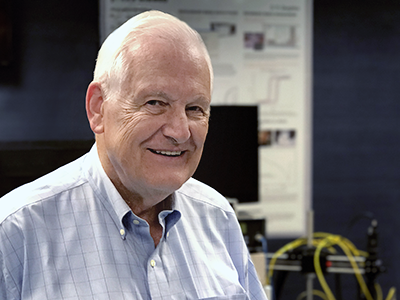

John Swartz
Chairman of the Board

Dr. John M. Swartz received a BSc in Ceramic Engineering from Alfred University and an MSc and a PhD in Electrical Engineering from the Ohio State University, where he was an Instructor, Assistant, and Associate Professor of Electrical Engineering for 17 years. While a graduate student at OSU, he worked as a researcher in the Solid-State Physics Group at the Battelle Memorial Institute in Columbus, Ohio, where he developed the theory for a fast neutron dosimeter which was worn by both the US and NATO troops during the Cold War. These devices were manufactured at Lake Shore Cryotronics, Inc. in the 1980s.
In 1967, John’s brother, David, asked him to make 35 gallium-arsenide (GaAs) diode temperature sensors for measurement over the temperature range of 1.5 to 400 K. These sensors were sold to Argonne National Lab, and based on this sale, the brothers started Lake Shore Cryotronics in 1968. The GaAs diode (the TG-100), the first cryogenic sensor of its type on the market, won an I•R100 Award in 1969. Other sensors followed, including the GR-200 capacitance carbon glass sensor, which was chosen by Research & Development Magazine as one of the 100 most significant new products of 1969.
In the 1970s, under Dr. Swartz’s technical leadership, Lake Shore introduced more new temperature sensors and measurement and control products. With Dr. Swartz as President and CEO starting in 1980, the company added industrial and systems divisions (with the 7000 Series AC susceptometer as its first system) as well as additional instruments, including current sources, cryopump monitors, and sensor scanners. Then, in the 1990s, as its instrument and sensor lines continued to expand, Lake Shore introduced the world’s first line of autotuning temperature controllers, instruments, and sensors for measurement of magnetic fields, and later began selling its 7300 Series VSM system and its first Hall effect measurement system.
In 2003, Dr. Swartz stepped down as President and CEO, appointing his son, Michael Swartz, as his successor. Dr. Swartz continues to serve as Chairman of the Board for Lake Shore and remains actively involved in R&D for Lake Shore’s next generation of measurement technology.
Select Publications
OptiCell Concept for Cell Culture Operations – Novel Technology for Cell Growth and Monitoring
E. Barbera-Guillem and J. M. Swartz, Genetic Engineering News, Vol. 20, No. 21, 2000.
Stability of Cryogenic Temperature Sensor Elements: Germanium and Carbon Glass
C. F. Clark Jr., V. Wang, P. R. Swinehart, and J. M. Swartz, Proceedings
of Instrument Society of America Conference, Philadelphia, PA, 1978.
Magnetoresistance of Carbon‐Glass Thermometers at Liquid Helium Temperatures
J. M. Swartz, J. R. Gaines, and L. G. Rubin, Review of Scientific Instruments, Vol. 46, Issue 9, 1177, 1975.
Cryogenic Temperature Sensors
J. M. Swartz, Instrumentation Technology, Vol. 21, Issue 1, Instrument Society of America, 33 – 38, 1974.
Diode and Resistance Cryogenic Thermometry: A Comparison
D. L. Swartz and J. M. Swartz, Cryogenics, Vol. 14, Issue 2, 67 – 70, 1974.
Electrical Characteristics of the Silicon Nitride‐Gallium Arsenide Interface
J. E. Foster and J. M. Swartz, Journal of The Electrochemical Society, Vol. 117, Issue 11, 1410 – 1417, 1970.
A Silicon Fast-Neutron Dosimeter with a Wide Sensitivity Range
M. O. Thurston, J. M. Swartz, R. R. Speers, and W. H. Closser, Neutron
Monitoring, Proceedings of the Symposium on Neutron Monitoring for
Radiological Protection, 245 – 251, 1967.
Analysis of the Effect of Fast‐Neutron Bombardment on the Current‐Voltage Characteristic of a Conductivity‐Modulated p‐i‐n Diode
J. M. Swartz and M. O. Thurston, Journal of Applied Physics, Vol. 37, No. 2, 745 – 755, 1966.
Experimental Calibrations of a Silicon Rectifier Developed as a Fast Neutron Sub-miniature Dosimeter
J. M. Swartz and L. Browne, IEEE Transactions on Nuclear Science, Vol. 10, Issue 3, 1963.
Radiative Recombination in Gallium Phosphide Point-Contact Diodes
H. C. Gorton, J. M. Swartz, and C. S. Peet, Nature, Vol. 188, 303 – 304, 1960.

